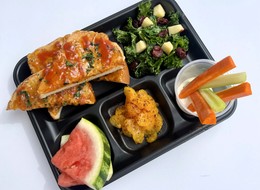For Schools
We all know that school districts want to keep their students safe and serve nutritious meals to foster their development and academic performance. But removing peanuts from
menus isn’t the solution.
Research shows that allergen management is the safer, more effective approach, endorsed by experts and organizations like the Centers for Disease Control and the American Academy of Allergy, Asthma, and Immunology.
Peanuts are a staple in school meals, offering nutrition, versatility, and affordability that students enjoy. By following best practices, schools can safely reintroduce peanuts and ensure inclusivity for all students.

Videos
School nutrition professionals love peanuts and peanut butter, and they also understand that allergen management is essential to keeping them on the menu. Watch this collection of brief and informative videos to learn the benefits of peanut foods in as part of school meals, address common misconceptions about peanuts in schools and discover best practices and tips for building and communicating an allergen management plan. You will be well on your way to understanding how to keep students with food allergies safe while providing other students with nutritious, delicious, and affordable peanut butter and peanuts.
Welcome to Peanuts in Schools
Welcome to Peanuts in Schools, a resource for school nutrition professionals and others interested in learning more about how to serve peanuts in schools when you are also serving students with peanut allergies.
Bringing Peanut Butter Back to Menu
NPB registered dietitian nutritionist Markita Lewis interviews Amy Caroll, RDN, of Lee County Schools in Fort Myers, Florida about her journey to bring peanut butter back to meet the district's needs and keep students with food allergies safe.
How Peanuts Meet Today’s School Nutrition Challenges
Now that we’re entering the third pandemic year, K-12 is stretched to the limit with supply chain issues, staffing shortages and rising food prices. School nutrition experts Dayle Hayes, MS, RD, and Jeanne Reilly, NDTR, SNS talk about overcoming obstacles, how and why peanuts and peanut butter are essential in these trying times and how to manage this common allergen in a school setting.
Communicating Food Allergy Management: Keys to Success
Sometimes it can be hard to talk about food allergy management in schools. Registered dietitian nutritionist and former school nutrition professional Sherry Coleman Collins shares five tips, inspired by the CDC’s Voluntary Guidelines for Managing Food Allergies in Schools and Early Care and Education Programs for more effective communication on this issue.
Why Peanut Butter Matters for Schools
School nutrition pros have many factors to consider when making menu decisions, from acceptability and nutrition to value and versatility. Learn why peanut foods are important for school nutrition programs from Marietta City Schools Nutrition Director Cindy Culver, RDN, and Sherry Coleman Collins, MS, RDN, LD.
How to Safely Serve Peanut Butter in Schools
Peanut foods and other allergens, like milk, eggs, and fish, are served safely in schools every day. Sherry Coleman Collins, registered dietitian nutritionist, food allergy expert and former school nutrition professional, shares the steps to consider to reduce risk, keep children with food allergy safer and provide nutritious, affordable, and delicious options with peanut ingredients to students without peanut allergy.
Resources
Advice and best practices for managing food allergies in schools are based on evidence, science and real-world experience. Here you will find free handouts to share with your team and school community that advises the do’s and don’ts, as well as guidance and experience from school nutrition leaders and allergy experts.

Best Practices for Allergen Management in Schools
Peanuts are a staple in school meals, offering nutrition, versatility, and affordability that students enjoy. By following best practices, s...

Bringing Peanut Butter Back to Schools
This resource is intended to help districts and schools interested in adding peanut butter back to their menu—or expanding their current use...

Guidelines for Managing Food Allergies in Schools
Educators and parents alike are asking, “what is the best solution for accommodating children with food allergies in schools?” Approximately...

How School Nutrition Experts Serve Peanuts and Peanut Butter
In this article, two experts in K-12 school nutrition share their insights on the importance of peanut butter in nutrition programs, advice ...

Prevention and Management of Allergic Reactions to Food in Child Care and Schools: Practice guidelines
Experts from around the world came together to evaluate and assemble the latest evidence-based recommendations for how to reduce the risk of...

School Nutrition Association Food Allergy Resource Center
SNA’s Food Allergy Resource Center is a one-stop shop for school nutrition professionals to learn about managing food allergies in schools. ...

CDC Food Allergy Management Toolkit
CDC’s toolkit contains tip sheets, training presentations and podcasts to help school staff implement the Voluntary Guidelines for Managing ...

FAACT School/Education Resource Center
Food Allergy & Anaphylaxis Connection Team provides resources for schools including a curricula program, posters, guidance on building a foo...

FARE
Food Allergy Research and Education provides free information, materials, and trainings for anyone in the school environment who is looking ...

SNA Webinar: Bringing Nutritious, Affordable, and Delicious School Meals to Life while Managing Common Allergens
Get inspired by creative ideas from a school chef to meet the needs of today’s savvy students. A nutrition scientist and research director r...
With USDA's Final Rule targeting sodium and added sugars, peanuts offer a tasty, nutrient-packed sol...
Get insights on managing food allergies confidently within school environments for a safe learning e...
With so many viewpoints on the internet, it’s hard to know who to listen to – is peanut oil safe for...
Nutritious and delicious: Peanut butter is back on the menu in Lee County schools, providing a whole...
FoodService Director magazine recently featured the National Peanut Board’s campus events at UMass a...
Peanuts promoted as safe, nutritious option at school conference.
Supporting School Nutrition Professionals During National School Breakfast Week
Empower students to transform school breakfast with creative leadership, from taste-testing to marke...



